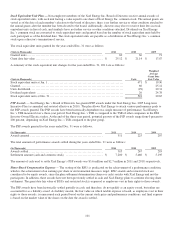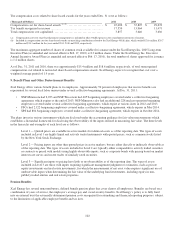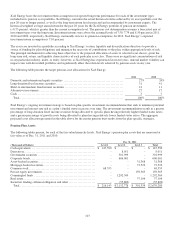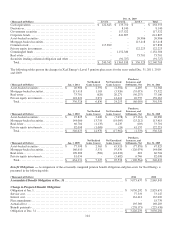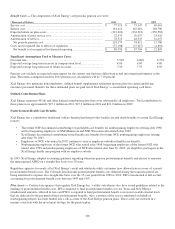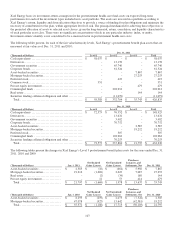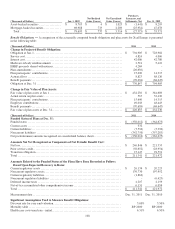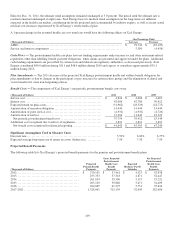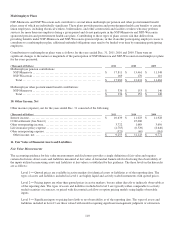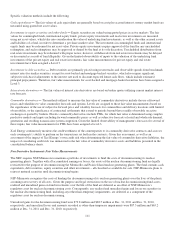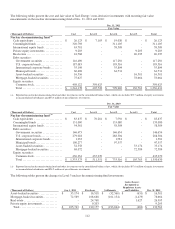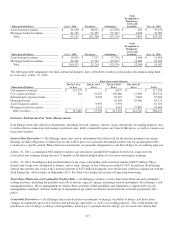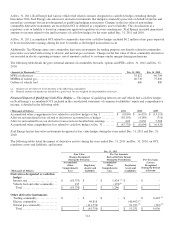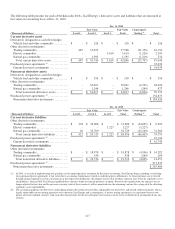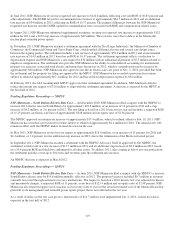Xcel Energy 2011 Annual Report Download - page 121
Download and view the complete annual report
Please find page 121 of the 2011 Xcel Energy annual report below. You can navigate through the pages in the report by either clicking on the pages listed below, or by using the keyword search tool below to find specific information within the annual report.111
Specific valuation methods include the following:
Cash equivalents — The fair values of cash equivalents are generally based on cost plus accrued interest; money market funds are
measured using quoted net asset values.
Investments in equity securities and other funds — Equity securities are valued using quoted prices in active markets. The fair
values for commingled funds, international equity funds, private equity investments and real estate investments are measured
using net asset values, which take into consideration the value of underlying fund investments, as well as the other accrued assets
and liabilities of a fund, in order to determine a per share market value. The investments in commingled funds and international
equity funds may be redeemed for net asset value. Private equity investments require approval of the fund for any unscheduled
redemption, and such redemptions may be approved or denied by the fund at its sole discretion. Unscheduled distributions from
real estate investments may be redeemed with proper notice; however, withdrawals from real estate investments may be delayed
or discounted as a result of fund illiquidity. Given the limited observability of inputs to the valuation of the underlying fund
investments of the private equity and real estate investments, fair value measurements for private equity and real estate
investments have been assigned a Level 3.
Investments in debt securities — Debt securities are primarily priced using recent trades and observable spreads from benchmark
interest rates for similar securities, except for asset-backed and mortgage-backed securities, which also require significant,
subjective risk-based adjustments to the interest rate used to discount expected future cash flows, which include estimated
principal prepayments. Therefore, fair value measurements for asset-backed and mortgage-backed securities have been assigned a
Level 3.
Interest rate derivatives — The fair values of interest rate derivatives are based on broker quotes utilizing current market interest
rate forecasts.
Commodity derivatives — The methods utilized to measure the fair value of commodity derivatives include the use of forward
prices and volatilities to value commodity forwards and options. Levels are assigned to these fair value measurements based on
the significance of the use of subjective forward price and volatility forecasts for commodities and delivery locations with limited
observability, or the significance of contractual settlements that extend to periods beyond those readily observable on active
exchanges or quoted by brokers. Electric commodity derivatives include FTRs, for which fair value is determined using complex
predictive models and inputs including forward commodity prices as well as subjective forecasts of retail and wholesale demand,
generation and resulting transmission system congestion. Given the limited observability of management’s forecasts for several of
these inputs, fair value measurements for FTRs have been assigned a Level 3.
Xcel Energy continuously monitors the creditworthiness of the counterparties to its commodity derivative contracts and assesses
each counterparty’s ability to perform on the transactions set forth in the contracts. Given this assessment, as well as an
assessment of the impact of Xcel Energy’s own credit risk when determining the fair value of commodity derivative liabilities, the
impact of considering credit risk was immaterial to the fair value of commodity derivative assets and liabilities presented in the
consolidated balance sheets.
Non-Derivative Instruments Fair Value Measurements
The NRC requires NSP-Minnesota to maintain a portfolio of investments to fund the costs of decommissioning its nuclear
generating plants. Together with all accumulated earnings or losses, the assets of the nuclear decommissioning fund are legally
restricted for the purpose of decommissioning the Monticello and Prairie Island nuclear generating plants. The fund contains cash
equivalents, debt securities, equity securities and other investments – all classified as available-for-sale. NSP-Minnesota plans to
reinvest matured securities until decommissioning begins.
NSP-Minnesota recognizes the costs of funding the decommissioning of its nuclear generating plants over the lives of the plants,
assuming rate recovery of all costs. Given the purpose and legal restrictions on the use of nuclear decommissioning fund assets,
realized and unrealized gains on fund investments over the life of the fund are deferred as an offset of NSP-Minnesota’s
regulatory asset for nuclear decommissioning costs. Consequently, any realized and unrealized gains and losses on securities in
the nuclear decommissioning fund, including any other-than-temporary impairments, are deferred as a component of the
regulatory asset for nuclear decommissioning.
Unrealized gains for the decommissioning fund were $79.8 million and $82.5 million at Dec. 31, 2011 and Dec. 31, 2010,
respectively, and unrealized losses and amounts recorded as other-than-temporary impairments were $87.5 million and $65.2
million at Dec. 31, 2011 and Dec. 31, 2010, respectively.


